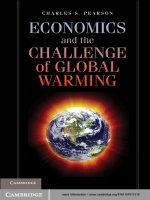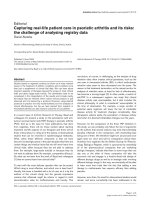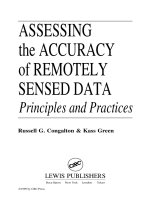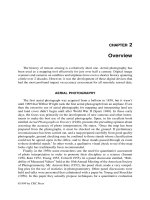International bussiness the challenge of global competition 11e chapter 02
Bạn đang xem bản rút gọn của tài liệu. Xem và tải ngay bản đầy đủ của tài liệu tại đây (726.16 KB, 33 trang )
chapter two
International Trade and
Foreign Direct Investment
McGraw-Hill/Irwin
International Business, 11/e
Copyright © 2008 The McGraw-Hill Companies, Inc. All rights reserved.
Learning Objectives
Appreciate the magnitude of international trade
Identify the direction of trade, or who trades with whom
Explain the size, growth, and direction of U.S. foreign
direct investment, worldwide and in the U.S.
Identify who invests and how much is invested in U.S.
Understand the reasons for entering foreign markets
Comprehend that globalization of international firm
occurs over seven dimensions and that a company
can be partially global in some dimensions and
completely global in others
2-3
Large International Firms Invest
Overseas, and They Also Export
•
Large American international firms responding to such factors as:
1. Global competition
2. Liberalization by host governments in
regard to foreign investment
3. Advances in technology
2-4
Large International Firms Invest
Overseas, and They Also Export
Note: Foreign sales refers to sales outside the home country of the company. All figures are based on 2005 fiscal year, as reported in 2006,
except for Wal-Mart Stores, whose fiscal year ended January 31, 2006. This list excludes BP, which was ranked the 4th largest, because the
company’s annual report did not provide information on either foreign sales or net income from foreign operations.
— information not provided in company annual report.
Source: Company annual reports, Fortune magazine’s 2006 Global 500 listing of world’s largest companies,
(July 14, 2006).
2-5
Large International Firms Invest
Overseas, and They Also Export
•
Supplying overseas markets
– Exporting to and production in those
markets
•
In order to establish and expand overseas operations
– International Trade - Including exports and
imports
– Foreign Direct Investment
– Foreign Sourcing
2-6
International Trade
•
Increase in volume of trade
Source: Monthly Bulletin of Statistics (New York: United Nations, June 1997), pp. 92–102 and 266–71; Monthly Bulletin of Statistics (New York: United Nations, August
2000), pp. 92–111 and 122; “World Merchandise Exports by Region and Selected Economy, 1980, 1985, 1990, 1995 and 1999–2001,” World Trade Organization, Statistics
Division, www.wto.org/english/res_e/statis_e/statis_e.htm (June 30, 2002); “World Exports of Commercial Services by Selected Region and Economy, 1980–2001,” World
Trade Organization, Statistics Division, www.wto.org/english/res_e/statis_e/statis_e.htm (June 5, 2002); “World Service Exports by Region and Selected Economy, 1992–
02,” International Trade Statistics 2003 (Geneva: World Trade Organization, 2003), pp. 171–74, 179–81; and “Growth in the Value of World Merchandise Trade by Region,
2004,” International Trade Statistics 2005 (Geneva: World Trade Organization, 2005) pp. 20, 23.
2-7
International Trade
Location of Worldwide Manufacturing Value-Added for Selected Regions (percentage of value added at current prices)
n.a. data not available. * 1980 data are actually for 1981, but listed at constant 1980 prices. Source: “Foreign Direct Investment: Foreign
Direct Investment Flows,” United Nations Conference on Trade and Development, (July 14, 2006).
2-8
International Trade
Note: Rankings are based on trade data for 2004.
Source: World Trade Organization, International Trade Statistics 2005 (Geneva: World Trade Organization, 2005), pp. 21, 23.
2-9
Direction of Trade
• Increasing
Regionalization of
Trade
Source: Monthly Bulletin of Statistics (New York: United Nations), July
2001, pp. 266–71, July 2000, pp. 258–61, June 1997, pp. 255–62, June
1993, pp. 266–71; Statistical Yearbook (New York: United Nations, 1969),
pp. 376–83; and “International Trade—World Exports by Provenance and
Destination,” July05-online.pdf (July 14,
2006).
2-10
Major Trading Partners: Their
Relevance for Managers
•
Why Focus on Major Trading Partners?
– The business climate in the importing
nation is relatively favorable
– Export and import regulations are not
insurmountable
– There should be no strong cultural
objections to buying that nation’s goods
– Satisfactory transportation facilities have
already been established
2-11
Major Trading Partners: Their
Relevance for Managers
– 5. Import channel members (merchants,
banks, and customs brokers) are
experienced in handling import shipments
from the exporter’s area.
– 6. Foreign exchange to pay for the exports
is available.
– 7. The government of a trading partner may
be applying pressure on importers to buy
from countries that are good customers for
that nation’s exports.
2-12
Major Trading Partners of the United
States (Table 2.4)
2-13
Major Trading Partners of the United
States (Table 2.4 cont’d)
Source: “U.S. Aggregate Foreign Trade Data, 1999 and Prior Years,” U.S. Foreign Trade Highlights, tables 10 and 11, U.S. Department of Commerce International Trade
Administration, “Table 11: Top 50 Suppliers of U.S. Imports in 2004,” U.S. Department of Commerce International
Trade Administration, www.ita.doc.gov/td/industry/otea/usfth/tabcon.html (July 14, 2006); “Table 10: Top 50 Purchasers of U.S. Exports in 2004,” U.S. Department of
Commerce International Trade Administration, www.ita.doc.gov/td/industry/otea/usfth/tabcon.html (July 14, 2006).
2-14
Major Trading Partners of the United
States
•
International trade exists because firms export
2-15
Foreign Investment
•
Divided into two parts
– Portfolio investment
• The purchase of stocks and bonds to
obtain a return on the funds invested
– Direct investment
• The purchase of sufficient stock in a firm
to obtain significant management control
2-16
Foreign Investment
•
FDI
– Volume
• Outstanding Stock of FDI
– The book value of all foreign direct
investment
• Annual Outflows of FDI
– The amount invested each year into other
nations
2-17
Figure 2.3 Stocks of Outward Foreign
Direct Investment, Selected Countries
Source: Various “Country Fact Sheets,” World Investment Report 2001, United Nations Conference on Trade and Development, Geneva,
October 2001, and World Investment Report 2005, United Nations Conference on Trade and Development, Geneva, September 2005.
2-18
Foreign Investment
• Annual inflows of FDI
– Where countries are investments being made
and where do investments come from (Table
2.5)
2-19
Table 2.5 Direction of Foreign Direct Investment
(Annual Flows) for Selected Regions and
Countries, 1985-2004 ($ billions)
2-20
Table 2.5 Direction of Foreign Direct Investment
(Annual Flows) for Selected Regions and
Countries, 1985-2004 ($ billions)
Note: Because of rounding, values may not equal 100%.
Source: Various “Country Fact Sheets,” World Investment Report 2001, United Nations Conference on Trade and Development, Geneva,
October 2001, and World Investment Report 2005, United Nations Conference on Trade and Development, Geneva, September 2005.
2-21
Foreign Investment
– Level and Direction of FDI
• Can only get an idea of the rate and
amounts of such investments and of the
places in which they are being made
– Trade Leads to FDI
• Foreign trade is typically less costly and
less risky than making a direct investment
into foreign markets
2-22
Foreign Investment
•
U.S. Foreign Direct Investment Abroad (figure 2.4a)
•
Foreign Direct Investment in the United States (figure 2.4b)
– Acquire Going Companies or Build Ones?
(figure 2.5)
2-23
Figure 2.4
2-24
Figure 2.5 International Investment
Position of the United States, 1976-2005
(billions of dollars)
Note: Figures are based on current cost. 2002 figures are preliminary.
Source: Elena L. Nguyen, “The International Investment Position of the United States at Year-End 2002,” Survey of Current Business,
July 2003, pp. 20–21;
2-25









